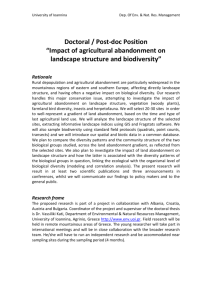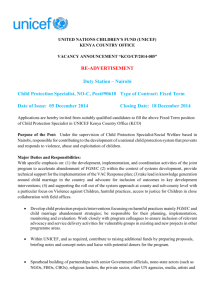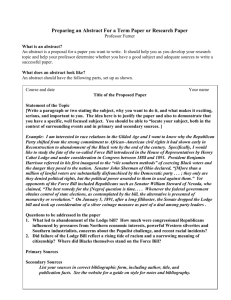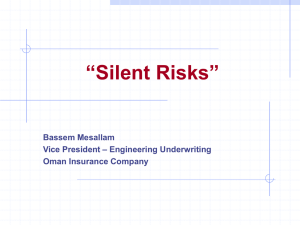AN ASSESSMENT OF THE CAUSES AND EFFECTS OF
advertisement
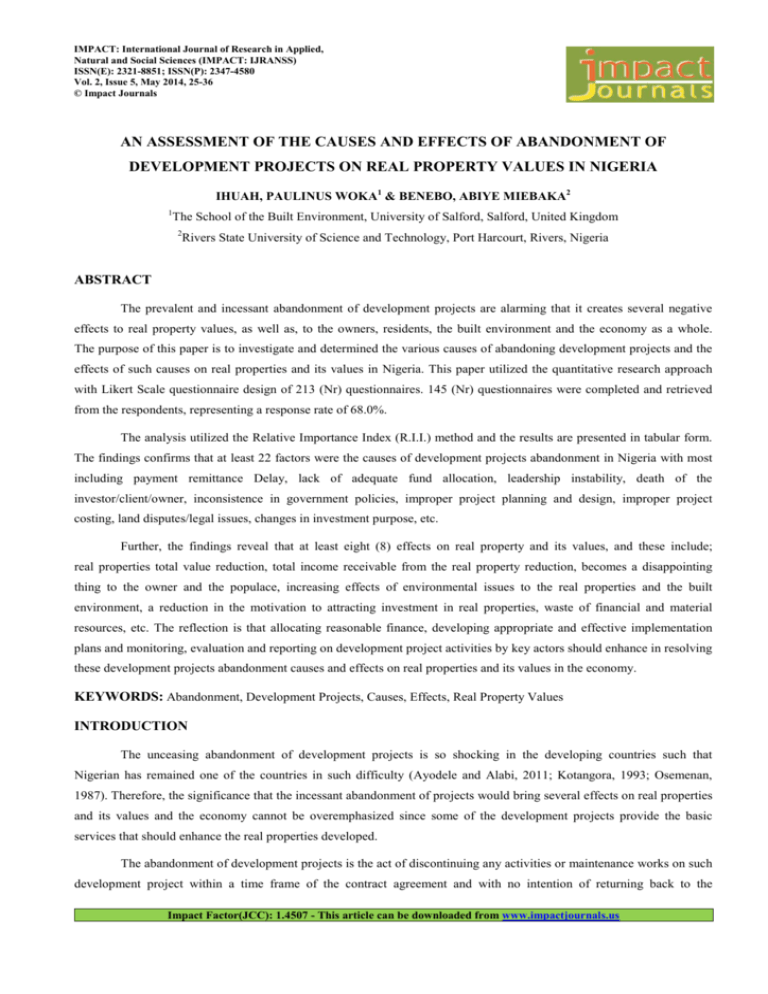
IMPACT: International Journal of Research in Applied, Natural and Social Sciences (IMPACT: IJRANSS) ISSN(E): 2321-8851; ISSN(P): 2347-4580 Vol. 2, Issue 5, May 2014, 25-36 © Impact Journals AN ASSESSMENT OF THE CAUSES AND EFFECTS OF ABANDONMENT OF DEVELOPMENT PROJECTS ON REAL PROPERTY VALUES IN NIGERIA IHUAH, PAULINUS WOKA1 & BENEBO, ABIYE MIEBAKA2 1 The School of the Built Environment, University of Salford, Salford, United Kingdom 2 Rivers State University of Science and Technology, Port Harcourt, Rivers, Nigeria ABSTRACT The prevalent and incessant abandonment of development projects are alarming that it creates several negative effects to real property values, as well as, to the owners, residents, the built environment and the economy as a whole. The purpose of this paper is to investigate and determined the various causes of abandoning development projects and the effects of such causes on real properties and its values in Nigeria. This paper utilized the quantitative research approach with Likert Scale questionnaire design of 213 (Nr) questionnaires. 145 (Nr) questionnaires were completed and retrieved from the respondents, representing a response rate of 68.0%. The analysis utilized the Relative Importance Index (R.I.I.) method and the results are presented in tabular form. The findings confirms that at least 22 factors were the causes of development projects abandonment in Nigeria with most including payment remittance Delay, lack of adequate fund allocation, leadership instability, death of the investor/client/owner, inconsistence in government policies, improper project planning and design, improper project costing, land disputes/legal issues, changes in investment purpose, etc. Further, the findings reveal that at least eight (8) effects on real property and its values, and these include; real properties total value reduction, total income receivable from the real property reduction, becomes a disappointing thing to the owner and the populace, increasing effects of environmental issues to the real properties and the built environment, a reduction in the motivation to attracting investment in real properties, waste of financial and material resources, etc. The reflection is that allocating reasonable finance, developing appropriate and effective implementation plans and monitoring, evaluation and reporting on development project activities by key actors should enhance in resolving these development projects abandonment causes and effects on real properties and its values in the economy. KEYWORDS: Abandonment, Development Projects, Causes, Effects, Real Property Values INTRODUCTION The unceasing abandonment of development projects is so shocking in the developing countries such that Nigerian has remained one of the countries in such difficulty (Ayodele and Alabi, 2011; Kotangora, 1993; Osemenan, 1987). Therefore, the significance that the incessant abandonment of projects would bring several effects on real properties and its values and the economy cannot be overemphasized since some of the development projects provide the basic services that should enhance the real properties developed. The abandonment of development projects is the act of discontinuing any activities or maintenance works on such development project within a time frame of the contract agreement and with no intention of returning back to the Impact Factor(JCC): 1.4507 - This article can be downloaded from www.impactjournals.us 26 Ihuah, Paulinus Woka & Benebo, Abiye Miebaka development (Spelman, 1993). Similarly, O’Flaherty (1993) while reflecting on property development projects suggest that it is when an owner or developer is ceasing to provide the required maintenance management to a developed property. However, real property development projects being a capital intensive undertaking should be critically analyzed to ascertain its feasibility and viability before embarking on it. But, on several occasions and as it had been observed, governments, contractors and agencies have abandoned development projects mid-way into construction and completion. The causes and effects of these development projects abandonments are not just peculiar to a particular reason rather cut across several reasons (Ayodele and Alabi, 2011), and as well as creating a total dwindling effects on the values of developed properties located close and within the vicinity. The expected prominence of any earmarked development projects is to be completed, while at the same time, adding values to the built environment aesthetics. Although, development projects are temporary endeavors undertaken to create a unique product and services with a defined beginning and ending date (Gardner, 2005). The accomplishment of such purposes should be realized at all times otherwise needless of such development (Gardner, 2005). The development projects specific in the study framework is infrastructural projects (such as; house, electricity, road, schools, and drainage). A real property developed project (housing estates or buildings) though amongst the development projects, whether it be tangible or intangible should be capable of having values, as well as having the right of: possessions; uses; and disposals; excisable upon it. But, these values are related to the type of interest substituting in that property and enhanced by the various infrastructures provided. Although, the location of the property and demand is equally important but accessibility and the availabilities of the infrastructures in the real property location and in the surrounding built environment should be of much more significant determinants in this study context. Values in itself are not intrinsic (Schram, 2012) rather depends on the benefits derivable from that property. While this remained the case for real properties, it is essential for any real property to have sustained improved values, and this is assumed to be influenced by the availability of the earlier mentioned infrastructures in the real property location. So, if the needed infrastructures are imperious in determining the property values, the question therefore is why are development projects which provide the necessary support to real properties, as well as enhancing its values abandoned in the society? Again, of what effects is this development projects abandonment having on total real property values in the built environment. Therefore, the study purpose is to investigate and assess the causes and effects of development projects abandonment on real property and its values. Hence, the objectives of the paper are: to investigate and determine the causes of development projects abandonment; and to assesses the effects of the development project abandonment on real properties and its value. The cogent of this study is on the premise that the expected real properties and its values in Nigeria are suspected to be dwindling as a result of incessant incompletion and abandonment of development projects. But, by exploring this context should help establish and recognize the causes and effects of development project abandonments by governments, policy/decision makers, educationalist and practitioners. This, through eradication of these causes should expect to eliminate these identified effects and sustain real properties and its values in the economy. THEORETICAL REVIEW ON PROJECT ABANDONMENT, CAUSES AND EFFECTS A Projects development particularly infrastructural projects are intended to provide new product and service to the community and at the same time promote the beauty of the built environment, but this benefits are undermined and Index Copernicus Value: 3.0 - Articles can be sent to editor@impactjournals.us An Assessment of the Causes and Effects of Abandonment of Development Projects on Real Property Values in Nigeria 27 unattained because of its incessant abandonment (Ayodele and Alabi, 2011). For example, osemenan (1987) concluded that Nigeria has become the ‘world’s junk-yard’ of abandoned projects worth billions of Naira. While Kotangora (1993) in supporting the fact contended that there about 400 uncompleted or abandoned development projects costing more than three hundred billion (#300 Billion) Naira embarked upon by successive governments. The development projects are classified as abandoned when the expected activities to be performed for the completion of the development is stopped because of many difficulties surrounding the development (http://dictionary.reference.com/browse/abandonment; Longman Dictionary, 2005). Huges, (1986) argues that it is the improper understanding and utilization of the basic project managerial principles such as improper focus of the management by rewarding the wrong actions for good and the lack of communication of the project goals that contributes to the situation. While Chan et.al., (2002) argued that the project abandonment result from the following: a lack of the project team promise; lack of contractor’s competencies; a lack of understanding of risk and liability assessments; a lack of the client’s competencies; a lack of the end users’ needs; and the end users imposed restrictions on the project development. Although, all development project environments are different and every organization operates differently, therefore, a set of causes may not be transferred from one project development environment to another. But, the use of a broader procedure for that subsequent project development should be imperative though the Nigerian development projects environment may seem similar; presenting the same threats to almost all development projects. Hence, the conceptual investigation of the causes of development projects abandonment in Nigeria in the subsequent sub-section of this study. Causes of Development Projects Abandonment in Nigeria Many development projects as earlier mentioned in the study are by their completion and provisions predicted would provide the needed products and services, and that should sustainably enhanced real properties and its values in any economy. But, for these development projects, certain issue has remained as the bane to their abandonment in the Nigeria economy (Ayodele and Alabi, 2011; Efenudu, 2010). These issues/causes subjectively are numerous such that they include: the inconsistence in government policies; persistent community eruption and interference; lack of proper project development timing; and inappropriate allocation of project finance. Others of these causes to development projects abandonment are identified and enumerated in Table 2, and some of these has also been acknowledged and evidenced in the works of Ayodele and Alabi, (2011), Akindoyemi (1989) and Aluko (2008). As such, much more explanations are limited in this literature sub-section but are recognized by this present study while few earlier stated causes are discussed. The inconsistencies in government policies as a factor that causes the development projects abandonment is mostly connected to where government leaderships changes (Efenudu, 2010). The new governments in most observed scenarios abandon pervious government policies or programs with the hidden understanding of embracing self-conceptualized projects. Although, this situation manifestation is made worse during the era of frequent military intervention (1983-1996) in polities in Nigeria, but the NHP (2011) stressed that even the present and past democratic dispensation had demonstrated this un-developmental character better by adopting the inconsistency concepts and syndromes in policy formulation and implementation in Nigeria system. This invariably should affect any other development project that expects to utilize the products and services ought to be provided by these projects such as real properties. Therefore, a policy that supports infrastructural projects development continuity is imperative as this would add to improve real properties and its values in an economy. Impact Factor(JCC): 1.4507 - This article can be downloaded from www.impactjournals.us 28 Ihuah, Paulinus Woka & Benebo, Abiye Miebaka Another serious cause of development projects abandonment is the continuous community eruption and interference in project developments. The community leaders, youths, and today includes the women groups are usually on illegal premises demanding an incurable sum of money as compensation before any development project could be carried out successfully in their area. They undermine that the benefits of these development projects are to improve the properties, its values, life and the built environment as a whole. But, difficulties are sustained to the contractors such that the projects are abandoned unless such contractor complies with the illegal demand. This must be eradicated if non-development projects abandonment is to be achieved and maintained in the economy such as in the Nigerian economy. Another facilitating factor to development projects abandonment is the organization/management incompetence (Efenudu, 2010). The technical management teams are those on the provision for temporary management of the development projects and it is expected that these are qualified personnel to help with the tracks for all the project development work breakdown structure. But, most constructing organization avoids these groups because of the high cost of employing those with the required expertise. However, they prefer to use those that have little or no knowledge just to maximize profit by reducing total capital outlay into the development. This afterward brings a diminishing effect that the project is terminated by the project owner, hence abandoned. Rubin and Seeling (1967) stressed that technical performance was a measure of successful project development and Avots (1969) similarly argued that the wrong choice of a project development manager and unsupportive top-management would cause a project development failure and/ or abandonment. Therefore, competency of the project development teams should be imperative in combating development projects abandonment because of the important products and service it provides to real properties and its value enhancement. Additionally, finance and timing constitute another factor causing project development abandonment. Here, three types of timing problems usually interfere with effective implementation of development project such that they include but not limited to the following: delays between project identification and start-up; delays during project implementation; and inappropriate time phasing of project activities (Efenudu, 2010; Aibinu and Jagboro, 2002). The developments of realistic project implementation schedules have received limited attention today, but the manifestation of this is the absence of an accurate timetable for the critical project development activities in many project design papers (Mark, 1984). However, the project development timing estimates that existed in the late 70s and 80s were extremely optimistic when compared with actual rate of project accomplishment today (Efenudu, 2010). For examples, the average time to complete 120 federal projects audited between 1979 and 1989 exceeded estimated time by more than 50% as contended by Efenudu (2010). This suggests that the average time lapse between completion of the development project conceptualization and design, the project agreement and the actual project implementation completion are more than as should usually be expected of any development projects in Nigerian system. However, in the case of finance, Ihuah and Fortune, (2013), Ihuah and Eaton (2013) and NHP (2011) stressed that a major constraint to development projects completion since 1960 to the present state of affair is a lack of funds. This is specific to the inappropriate allocation of the required funds to development projects and this have the imperative effect of causing the project to be abandoned. Finance is the sustaining factor for any project accomplishment and where such is insufficient or inappropriately allocated; the projects tend to suffer abandonment scenarios. Therefore, it important that proper allocation of the required funds is made for any development projects to avoid the projects crippling into Index Copernicus Value: 3.0 - Articles can be sent to editor@impactjournals.us An Assessment of the Causes and Effects of Abandonment of Development Projects on Real Property Values in Nigeria 29 abandonment situation in the economy. At the same time, the project development timing should be properly conceptualized, planned and implemented accordingly. The other causes including unjustified project aim or not meet, unplanned urban areas, payment delays, death of the investor/client/owner, land disputes/legal issues and changes in investment purpose, improper project planning and design, climatic condition, improper project costing, increasing material costs and sometimes lacking, natural disaster occurrence, a lack of stakeholders’ involvement, a lack of project mission communication, a lack of risk assessment, a lack of need assessment, project manager incompetence, and bureaucratic bottleneck. These have also been identified as the cause of development projects abandonment by Ihuah and Fortune, (2013), Ihuah and Eaton, (2013) and Ayodele and Alabi, (2011). Therefore, a brief conceptual review of the effects of development projects abandonment on real properties and its values is contextualized. Effects of Development Projects Abandonment on Real Property and its Values Development projects abandonment as earlier theorized involve the complete absconding from accomplishing a project objectives, and when this happen, all the social, environmental and economic activities that expects to be supported by the new products and services provision are detracted. The general effects are assumed to include: waste of resources; declining in property value; loss of community and neighborhoods aesthetics values (Efenudu, 2010). In the case of the declining real properties and its value, Efenudu (2010) suggested that project abandonment affects properties within a neighborhood by lowering property values. This value loss or reduction is related to the property total value such as the market value, which is the value at which a property would bring when determined by the open market. Others are the property value in use, the property investment value, the property liquidation value, the assessed value of the property, the insurable property value and the property going concern value. Also, there is a loss on community and neighborhood aesthetics characteristics which the anticipated development projects on completion ought to provide to enhancing the built environment. But, the unattractive nature of the property as a result of a lack of the needed facilities has remained incessant in the Nigeria economy. For example, when a building property has been raised and later abandoned, it makes no positive aesthetic values, pleasures and contributions to a neighborhood instead become eyesores to the vicinity. Further, development projects abandonment contributes to the effect of wasted resources and loss of tax revenue (Ayodele and Alabi, 2011) to the governments and other groups in the economy. Real property development projects are usually capital intensive and when abandoned and/or left uncompleted, the expected returns are lost and the already capital outlay is apparently wasted. Therefore, every development projects should be completed as earmarked. However, the study in the following session would investigates and assesses through a questionnaire survey the causes of development projects abandonment and the overall effect on real properties and its values. Hence, the methodology of this study. THE STUDY METHODOLOGY This study utilised questionnaire surveys to collect data. A total of 213 questionnaires were developed using the five (5) point Likert scale method (5 = Strongly Agreed (SA); 4 = Agreed (A); 3 = Unsure (US); 2 = Disagreed (DA); and 1 = Strongly Disagreed (DSA)). The questionnaire is administered to the selected respondents who were identified using purposive random sampling approach. These questionnaires were administered to the landlords of property; residents/tenants, estate surveyors and valuers firm and project development contractors/professionals. This groups were Impact Factor(JCC): 1.4507 - This article can be downloaded from www.impactjournals.us 30 Ihuah, Paulinus Woka & Benebo, Abiye Miebaka chosen because they represent the main groups of stakeholders having stakes and involvement in the development projects, and are those problem been investigated is expected to affect most. Also, on the researcher judgmental knowledge and as it is most convenient in this study. However, 145 questionnaires were returned with complete answers representing a response rate of 68.0%. This response rate was acceptable in a study with such a total questionnaire sample size (Kobbacy, 2013). The data was analysed utilising the Relative Importance Index (R.I.I) approach that was advocated for and used by Lim and Alum (1995) in their work. This is given as adjusted in this study as: R.I.I = (5n5+ 4n4 + 3n3 +2n2 + n1) /5N) Where: n5 = Strongly Agree (SA); n4 = Agree (A); n3 = Unsure (US); n2 = Disagree (DA); n1 = Strongly Disagree (SDA); and N = number of respondents. RESULTS AND DISCUSSIONS This section provides the results/findings of the analysis carried out on the gathered data as well as providing discussion on each category or subsection. These are on the project situation and benefits in the environment (Table 1), the causes of project abandonment (Table 2) and the effect of the abandonment on real properties and its values as well as the ranking of the effects (Table 3). This was aimed to addressing the study purpose and objectives. Table 1: Projects Situation and its Benefit in the Built Environment S/No 1 2 3 Situation and Benefit Project exist to bring about the birth of a new product Project abandonment are predominant in our society today(civil construction projects) Some projects are successfully implemented, completed and commissioned while most are abandoned mid-way 1 0 2 0 3 5 4 15 5 125 R.I.I 0.9660 0 0 10 15 120 0.9520 0 0 15 35 95 0.9103 The results in Table 1 assessed the current condition of certain projects and the benefit of what the project is expected to add to the immediate built environment. The findings reveals that the case of project exists to bring about the birth of new product had R.I.I value of 0.9660. While project abandonment are predominant in our society today had a R.I.I value of 0.9520. The question of some projects is successfully implemented, completed and commission while most are abandoned mid-way was apparently unlike the other as it had a R.I.I Value of 0.9103. The overall findings in this theme confirm in the study circumstance that development projects are delivered to the society to bring about new products and services. This agrees with the opinion of Franks (2006) that projects are developed to create a unique products and service in the built environment. It further confirms that most projects are abandoned in Nigeria and with fewer of the projects successful completed, which is in agreement with the argument of (Ayodele and Alabi, 2011; Kotangora, 1993; Osemenan, 1987) indicated in their works and reports. It is imperative to sustain all measures that should ensure that projects that has been designed, planned for and undergoing implementation are completed rather than allowing those projects to be abandoned mid-way into construction and should be unwelcomed in Nigeria economy and/or any other country’s economy. It would be difficult to even commit further resource to continue the development as the issue of project cost variations may arise and that alone is likely going to increase the cost of the projects. Another scenario might be where there is a change of Index Copernicus Value: 3.0 - Articles can be sent to editor@impactjournals.us 31 An Assessment of the Causes and Effects of Abandonment of Development Projects on Real Property Values in Nigeria government and the new government might not be willing to continue with such project. In all, whatever may be the scenario, sustaining the completion of the project as designed and planned is something that should not be compromised by any economic system, and if the promotion of the aesthetic value of the built environment was importance to a system. Table 2: Factors Causing Abandonment of Projects Rank 1 2 3 4 5 6 7 8 9 10 11 12 13 14 15 16 17 18 19 20 21 22 Causes for Abandoning Projects Payment Remittance Delay Lack of adequate fund allocation Leadership Instability Death of the Investor/Client/owner Inconsistence in government policies, Improper Project Planning and Design Improper Project Estimates Land or Legal Disputes Project Aim Unjustified or Not Meet Change of Investment Purpose Natural Disaster Community Interference, Climatic Conditions Materials Increasing Costs and Lacks Lack of Project Risk Assessment Unplanned Urbanization System Project Manager Incompetence Lack of Stakeholders Involvement Improper Project Budgeting Project Mission Communication Lacking Lack of Proper Need Assessment Bureaucratic Bottleneck 1 0 0 0 0 0 0 0 0 0 0 0 0 0 0 0 0 0 0 0 0 0 0 2 0 0 0 0 0 0 0 0 3 0 0 5 0 0 0 0 0 0 0 0 0 0 3 0 0 0 0 5 0 0 0 7 5 0 10 15 15 18 12 15 10 0 20 40 65 4 25 30 35 40 30 47 45 46 25 50 60 30 40 36 40 55 55 70 89 63 34 55 5 120 115 110 105 110 98 100 99 110 90 85 100 90 94 87 78 75 65 56 60 70 25 R.I.I. 0.9660 0.9600 0.9520 0.9500 0.9450 0.9400 0.9400 0.9370 0.9340 0.9172 0.9172 0.9103 0.9100 0.9100 0.8952 0.8910 0.8830 0.8800 0.8772 0.8441 0.8414 0.7500 From Table 2, the findings confirm that at least 22 factors were the causes for which most projects are abandoned in Nigeria and these factors includes: payment remittance Delay (R.I.I 0.9660); a lack of adequate fund allocation (R.I.I 0.9600); leadership instability (R.I.I 0.9520); death of the investor/client/owner (R.I.I 0.9500); inconsistence in government policies (R.I.I 0.9450); improper project planning and design (R.I.I. 0.9400); improper project estimates (R.I.I. 0.9400); land disputes/legal issues (R.I.I. 0.9370); unjustified project aim or not meet (R.I.I 0.9340); changes in investment purpose (R.I.I. 0.9172); and natural disaster (R.I.I. 0.9172). Others are including; community interference (R.I.I. 0.9103), climatic condition (R.I.I. 09100), increasing material costs and sometimes lacking (R.I.I. 0.9100), a lack of risk assessment (R.I.I. 0.8952), unplanned urban system (R.I.I.0.8910), project manager incompetence (R.I.I. 0.8830), a lack of stakeholders’ involvement (R.I.I.0.8800), improper project budgeting (R.I.I. 08772), a lack of project mission communication (R.I.I.0.8441), a lack of need assessment (R.I.I. 0.8414), and bureaucratic bottleneck (R.I.I. 0.7500). The delay in remittance of money due to the development projects contractors is a factor amongst the causes of project abandonment, and that is in agreement with the findings of Ayodele and Alabi (2011) that delays in remittance of payment due for a project to the contractor is a bane and a cause to project abandonment. This delay situation might last more than one year, and in that case, the contractor will eventually abandon the project as there would be no money to continue the project implementation. Therefore, sufficient and effective efforts should be made in eliminating this cause so that projects cannot longer be abandoned rather completed within the specified delivery time and date. Another significance cause amongst the causes as confirmed in the findings is a lack of adequate funds allocation. Impact Factor(JCC): 1.4507 - This article can be downloaded from www.impactjournals.us 32 Ihuah, Paulinus Woka & Benebo, Abiye Miebaka This is importance to abate as adequate funds allocation to project implementations is imperative if projects are expected not to be abandoned, and this is supported with the contention that the project owners’ cash flow in the project implementation is a cause to project abandonment (Odenyinka and Yusuf (1997). Other causing factors such as leadership instability, death of the investor/client/owner, change of investment purpose, in consistences in government policies, land or legal disputes, and improper project planning and design, natural disaster and incompetent project manager, are in agreement with the findings of Ayodele and Alabi (2011) work on causes of construction project abandonment in Nigeria. The leadership and in consistences in government policies syndrome is such that any incoming government do not encourage project continuity instead devises a selfish motivational project to start up and this in effect renders the already commenced project to be abandoned. Land or legal disputes is so much pronounced that even most of the disputes take ages to be attended to in the court before providing judgment on such disputes, and because legal dispute exist, no project implementation shall continue or even commence unless such dispute is/are completely resolved. The other issue of improper project planning and design and incompetent project manager must be ruled out through providing the project implementation with a competent personnel that should be able to provide adequate planning and designing of the project as well as ensure proper implementation (Ezenwa, 2004; Adedeji, 1998; Opara, 1986). This circumstance should completely be removed since the development projects is/are expected not to be abandoned. The issue of natural disaster is sometime unpredictable as it is opined here as an ‘‘Act of God’’, however, human activities could contribute to natural disaster occurring such as the continuous crude oil exploitation in the Niger Delta of Nigeria. In all these causes, it is expected that proper project risk assessment is undertaken for project before commencing the implementation as this should help to explain the possible dangers and the mitigation measures. Another seriously factor causing project abandonment in Nigeria as indicated by the study is the incessant community interferences in project development and management. Most communities have through the illegal agitation for homages and other demands, and where it is not meet by the contractor, they invade into the project site, damaging and prowling most materials predestined to be used in the development/construction. This, in most cases has led to many contractors/developer to abandonment the development projects with no immediate hope of returning to site. However, in effort to resolving this cause, the government promulgated a law that bared any community from interfering in any project implementation and this must be fully enforced in the circumstance to avoid project abandonment. The remaining causes of project abandonment such as: improper project estimate, unjustified project aim, change to investment purpose, climatic condition, increasing material costs and sometimes lacking, unplanned urbanization system, lack of stakeholder involvement, improper project budgeting, lack of proper project task communication, lack of need assessment and bureaucratic bottlenecks, are also confirmed in this study as the causes of project abandonment. These are also supported by the works of Ihuah and Fortune (2013), Ihuah and Eaton (2013), Ayodele and Alabi (2011), Aluko (2008), Ayodele (1998), and Abdul Kadir, et al., (2005), who in their study stressed that the abandonment of projects are associated with all of or any of these factors/causes. For instance, a lack of stakeholders’ participation in project implementation can detract the achievement of the project mission and at the short run causes the development project to be abandoned. This may be particular to the situation that the expected project aim is not being justified or met. Also, it is normal that every project development should have a need assessment before embarking on such project. Index Copernicus Value: 3.0 - Articles can be sent to editor@impactjournals.us 33 An Assessment of the Causes and Effects of Abandonment of Development Projects on Real Property Values in Nigeria This is a procedure that will justify whether the expected project development is needed in that area before commencing and completing the development, rather than having the project in a void situation (unproductive period) at the end. However, in a proposition to establishing the effects of these causes of development projects abandonment on real properties and its values, Table 3 emerged. In the table, the various effects are provided and ranked using the Relative Important Index (R.I.I) values for each, and subsequently, discussion follows. The ranking in this frame was aimed to establish which effect has more magnitude effect using their individual R.I.I. value to real properties and its values though all these identified effects have potential impact on real property values. Table 3: Effects of Project Abandonment on Real Property Rank 1 2 3 4 5 6 7 8 Effects on Real Property It affects the real property total values reduction It affects the total income receivable from real property It becomes a disappointing thing to the owner and the populace It increases the negative effects of environmental issues to the real property and the built environment It negatively reduces the motivation to attracting investment in real properties It becomes a waste of Financial and Material Resources Employment opportunity in real property and other sectors are impacted negatively It deprive government the expected revenue from property tax 1 0 0 0 2 0 0 0 3 0 0 0 4 5 6 10 5 140 139 135 R.I.I 0.9931 0.9917 0.9862 0 0 0 20 125 0.9724 0 0 0 35 110 0.9520 0 0 0 40 105 0.9450 0 0 0 55 90 0.9241 0 0 0 60 85 0.9172 The findings in Table 3 that assessed and established the effects of abandoning project especially infrastructural projects on real properties confirm that eight (8) effects were significance. These effects on real properties however are suggested to be negative, and these are: real properties total value reduction (R.I.I 0.9931 and ranked 1st); total income receivable from the real property reduction (R.I.I 0.9917 and ranked 2nd); becomes a disappointing thing to the owner and the populace (R.I.I. 0.9862, ranked 3rd); increasing effects of environmental issues to the real properties and the built environment (R.I.I. 0.9724, ranked 4th); a reduction in the motivation to attracting investment in real properties (R.I.I. 0.9520, ranked 5th); becoming a waste of financial and material resources (R.I.I. 0.9450 and ranked 6th); a loss of employment opportunity in real properties and other sectors (R.I.I. 0.9241 and ranked 7th); and depriving the government the expected revenue receivable from property taxes (R.I.I. 0.9172 and ranked 8th). The total values of real property is the value comprising of the market value, value–in-use, going concern value, investment value, liquidation value, assessed value, and insurance value (Schram, 2012). These values are sustained in the real properties through availabilities of certain projects provision such as accessible and usable roads to the property location, drainages to channel erosion away from flooding the properties and electricity supply in the neighborhood. But, where these projects are abandon or no present at all in the neighborhood, the consequences is to bring a reduction on the combined values of what the properties ordinarily should have being when they are completed and provided in the area. This agrees with the assertion of Efenudu (2010) that project abandonment would affect the property values in a locality. Another effect of abandoning projects on real properties is the reduction in the total income receivable from the properties located within the neighborhood. Most at times, this income is the rental income which is the rent paid to the landlord by a leaseholder for using the property in agreed manner or purpose. However, if the property lacks the essential services, the rent that the landlord expects of the property would be reduced while the leaseholder is expecting cheaper rent Impact Factor(JCC): 1.4507 - This article can be downloaded from www.impactjournals.us 34 Ihuah, Paulinus Woka & Benebo, Abiye Miebaka to be passing on the properties in the neighborhood. In this circumstance, the expected income receivable of the properties where the development projects are provided should be enhanced. Again, where projects are abandoned, it becomes disappointing thing to the owner, developer and even the general populace. This, Aluko (2008) acknowledges as one amongst the major effects of project abandonment in an individual and the country as a whole. The other effects are the increasing negative effect of environmental issues to the real properties such as the problems of flooding, traffic congestion and the encouraging road deterioration, air and water pollution, drug addiction and illness/health hazards in the neighborhood. This is particularly where there are no developers on site to control the impact of these problems to the properties in that neighborhood. For the reduction in the motivation of attracting further investment in real properties by developer in that neighborhood it’s not out of place since most developer are profit oriented and would not appreciate investing in areas that required further capital outlay in the project development. However, the effects of waste of financial and material resources, unemployment opportunity in real property firms and other sectors and the deprivation of government of the expected revenue from property tax has also been acknowledged by Ayodele and Alabi (2011) and Aluko (2008) as the effects of project abandonment. Though, it might have been conceptualized in the context of this study. CONCLUSIONS AND RECOMMENDATIONS The study has demonstrated that there are at least twenty-two (22) causes of projects abandonment and that the resulting effects of the abandonment have at least eight (8) far-reaching effects on real properties. In a general perspective however, the study has established that projects abandonment is a contributing factors or issues to urban decay in an economy. The paper further determined that if the incessant causes are meticulously tackled through implementing various measures opined to each cause in the study; it is expected that projects abandonment will be a thing of past in the country. This should be promoting the total values of real properties as well as enhancing the real properties immovability and sustainability in an economy whether it is in developing or developed countries. An innovative planning and best practice project management approach such as developing reasonable implementation plans, on timely monitoring, evaluating and reporting on project activities. Also, it should be done in line with the development projects plans, as well as providing excellent time phasing for the project, introducing modifications if necessary and rewarding staff for overcoming procedural and other barriers that could delay implementation activities is/are imperative in this study circumstance. The governments in efforts to resolved to what the study suggest as “total no project abandonment” should sustainably promote the convention of providing adequate policies and the continuity of those policies by any incoming government. It is further recommended that timely release of project funds to project developers/contractors should significantly facilitate the effective and efficient completion of development projects as at the time expected. While this responsibilities are not only left for the government and the development projects contractors/developers, the practitioners, agencies and other stakeholder providing and executing projects should adhered to these through advocacy and educational interventions which should provide empowerment to the citizens. REFERENCES 1. Abdul Kadir, M.R.; Lee, W.P.; Jaafar, M.S.; Sapuan, S. M. and Ali, A.A.A. (2005) "Factors Affecting Construction Labour Productivity for Malaysian Residential Projects", Vol. 23 Iss: 1, pp.42 – 54. Index Copernicus Value: 3.0 - Articles can be sent to editor@impactjournals.us Structural Survey, An Assessment of the Causes and Effects of Abandonment of Development Projects on Real Property Values in Nigeria 2. 35 Adedeji, A.O (1998), Inflation of Production Planning Techniques on the Performance of Construction Firms in Nigeria, Journal of the Federation of Building Contractor in Nigeria, Vol. 13, Iss. 1, pp. 3-24. 3. Aibinu, A. A. and Jagboro, G. O. (2002), The Effects of Construction Delays on Project Delivery in Nigeria Construction Industry; International Journal of Project Management, Vol. 20, pp. 593-599. 4. Akindoyemi, A. (1989), the Management of Abandoned Project, Journal of Nigerian Institute of Building, Vol. 1, Iss. 2, pp. 27. 5. Aluko O.O. (2008) Construction project abandonment in Nigeria: A Threat to National Economy; Knowledge Review, Vol. 16, Iss. 3, pp. 18 – 23. 6. Avots, I. (1969) why does projects management full? California Management Review, pp.77-82. 7. Ayodele, E.O. and Alabi, O. M. (2011), Abandonment of Construction Projects in Nigeria: Causes and Effects; Journal of Emerging Trends in Economics and Management Sciences (JETEMS), Vol. 2, Iss. 2, pp. 142-145. 8. Chan, A.P.C., Scott, D. and Lam, E.W.M. (2002) Framework of Success Criteria for Design/Build Projects. Journal of Management in Engineering, Vol. 18, Iss. 3, pp. 122-8. 9. Definition of Abandonment; Available at http://www.google.co.uk/url?sa=t&rct=j&q=&esrc=s&source=web&cd=1&ved=0CC4QFjAA&url=http%3A% 2F%2Fdictionary.reference.com%2Fbrowse%2Fabandonment&ei=EapGU-2KHIy6hAf4oD4Bg&usg=AFQjCNHP4ledlum_kC1-9GhZMnpQVsrMHQ&bvm=bv.64507335,d.ZG4&cad=rja (assessed on 04/04/2014) 10. Efenudu, F. O. (2010); Causes and Effect of Abandonment of Project on Property Value; A Case of Port Harcourt; Unpublished First Degree Dissertation, Department of Estate Management, Faculty of Environmental Sciences, Rivers State University of Science and Technology, Nigeria. 11. Ezenwa, F. O. Junior (2004); Project Procurement Method in Due Process or How to Execute Capital Project Effectively; Department of Physical Planning and Development, Nigerian Universities Commission Abjua, Nigeria. 12. Franks, T. R. (2006), Sustaining Projects Benefits: Masters Course Manual. University of Bradford, UK: Centre for International Development 13. Gardiner, P.D. (2005). Project Management: A Strategic Planning Approach: Palgrave Macmillan, USA and UK. 14. Hughes, M.W (1986) Why projects fail: The effects of ignoring the obvious” IndEng, Vol. 18, pp.14-18. 15. Ihuah, P.W., & Fortune, J.C. (2013). Toward a Framework for the Sustainable Management of Social (Public) Housing Estates in Nigeria. Journal of US-China Public Administration, 10(9), 901-913. 16. Ihuah, P.W. and Eaton, D. (2013) “A Framework for the Sustainable Management of Social (Public) Housing Estates in Nigeria: a pilot study; A Paper Presented at RICS COBRA Research Conference, New Delhi, India (available at www.wrics/cobra.com) Impact Factor(JCC): 1.4507 - This article can be downloaded from www.impactjournals.us 36 Ihuah, Paulinus Woka & Benebo, Abiye Miebaka 17. Kobbacy, K. (2013), Introduction to Quantitative Research-Part 2: Estimation, Significant Tests & Correlations and Decision Models. Available at: http://blackboard.salford.ac.uk/bbcswebdav/pid-749238-dt-content-rid-1236192_1/courses/NBPMROAR/Estimation%20Significant%20Tests%20Correlation%20and%20Decision%20Models%20%5B201213%5D.pdf (accessed on 20/06/2013). 18. Kotangora, O. O. (1993); Project Abandonment, Nigerian Tribune. 19. Lim, E. C. and Alum, J. (1995), Construction Productivity: Issues Encountered by Contractors in Singapore; International Journal of Project Management, Vol.13, Iss.1, pp. 51-58. 20. Mark, S. (1997); Abandoned building models for legislative and enforcement reform; Trinity College, Hartford U.S.A. Available at: http://www.trincoll.edu/depts/ten/, Research-Reports (accessed on 20/03/2014). 21. NHP (2011) National Housing Policy Draft; Federal Government of Nigeria, Abuja. 22. O’Flaherty, B. (1993) Abandoned Building: A Stochastic Analysis; Journal of Urban Economics, Vol. 34, pp. 43-74. 23. Odenyinka, H. A. and Yusuf, A. (1997); the Causes and Effects of Construction Delays on Cost of Housing Project in Nigeria; Journal of Financial Management and Property and Construction, Vol. 2, pp. 31-41. 24. Opara, N. (1986); Construction Management Control and Planning; Journal of Construction Economics, Vol. 3, pp. 12-15. 25. Osemenan, I. (1987); Project Abandonment; New Watch Magazine, Vol. 1, pp. 15. 26. Rubin, I.M and Seeling, W. (1967) “Experience as a factor in the selection and performance of project managers” IEEE Trans Eng Management, Vol. 14, Iss. 3, PP.131-134. 27. Schram, J.F. Jr. (2012); Real Estate Appraisal, Sixth Edition, Rockwell Publishing, USA. 28. Spelman, W. (1998); Abandoned Buildings: Magnets for Crime; Journal of Criminal Justice, Vol. 21, National Vacant Properties Campaign. Index Copernicus Value: 3.0 - Articles can be sent to editor@impactjournals.us


